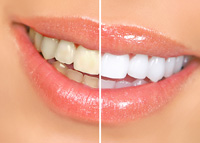
No doubt about it. We’re living longer, we’re living better. All that effort put into diet and exercise is paying off. And while you’re going through your paces on the treadmill, consider another part of you that might need a bit of improvement: your smile and whether or not you have white teeth.
With age, one of the first things to go is the freshness of your smile. At about thirty, tooth color begins to dim. There is a natural tendency for dentin, just beneath the enamel, to yellow. And if you smoke or overindulge in coffee or cola, the darkening can be dramatic. Exercise and low-fat foods count for less if your smile gives you away.
But just as our health habits have improved, so has cosmetic dental technology. Now we have the tools and teeth whitening products to perfect the color, and the healthful look, of your teeth.
Teeth whitening systems take many forms. There are gels and solutions accelerated by light; laser tooth whitening is coming into use to “jump-start” the tooth whitening process. We can change color fast or over time.
In any case, the result is visible in days and, with touch-ups, will last as long as you do.
You’ve lived this long, you’ve earned it. While perfect thighs are next to impossible, a pretty smile is within everyone’s reach. Go for it; don’t let your smile age faster than the rest of you.
Tooth whitening (or bleaching) is a simple, non-invasive dental treatment used to change the color of natural tooth enamel and is an ideal way to enhance the beauty of your smile.
Because having whiter teeth has now become the number one aesthetic concern of most patients, there are a number of ways to whiten teeth. The most popular method is using a home tooth whitening system that will whiten teeth dramatically. Since tooth whitening only works on natural tooth enamel, it is important to evaluate replacement of any old fillings, crowns, etc. Replacement of any restorations will be done after bleaching so they will match the newly bleached teeth.
Tooth whitening is not permanent. A touch-up maybe needed every several years, and more often if you smoke, drink coffee, tea, or wine.
Reasons for tooth whitening:
What does tooth whitening involve?
This type of tooth whitening usually requires two visits. At the first appointment, impressions (molds) will be made of your teeth to fabricate custom, clear plastic, trays.
At your second appointment, you will try on the trays for proper fit, and adjustments will be made if necessary. The trays are worn with special whitening solution either twice a day for 30 minutes or overnight for a couple of weeks depending on the degree of staining and desired level of whitening. It is normal to experience tooth sensitivity during the time you are whitening your teeth, but it will subside shortly after you have stopped bleaching.
You will receive care instructions for your teeth and trays, and be encouraged to visit your dentist regularly to help maintain a beautiful, healthy, white smile.
There are many options available for tooth whitening depending on the health of your teeth and the degree of patient motivation. Patients may choose to whiten both the upper and lower arches as well as just individual teeth that appear in the smile zone. Whitening can be used to correct many tooth discolorations which may have been caused by staining, chemical damage to the teeth, or simply by aging. Certain teeth may not lighten if there is extreme discoloration. They may require veneers or porcelain crowns. The main advantage to whitening is that it corrects brown, yellow, and mottled tooth staining. It is a long lasting solution for restoring brightness to a smile, and it does work on people of all ages.
Take home whitening is a method by which custom trays are fabricated specifically for the patient based on impressions in the mouth. This is a very quick appointment at the dentist where impressions are taken. Within a few days, trays are ready for pick up along with the whitening material to take home. The whitening material is then applied to the tray at home and applied over a short period of time. Amount of time may vary but generally is 3-4 hours every night for a week. These trays are clear and can be applied even during daytime. With time, the whitening material takes the stain out of the enamel without altering tooth structure or any dental work. Once a brilliant shade has been reached, photos are then taken to compare before and after results.
In office whitening is a nice alternative for patients that do not want to wear whitening trays at home. This procedure takes a little over an hour in office. A special light accelerates the whitening process. The results are excellent!
